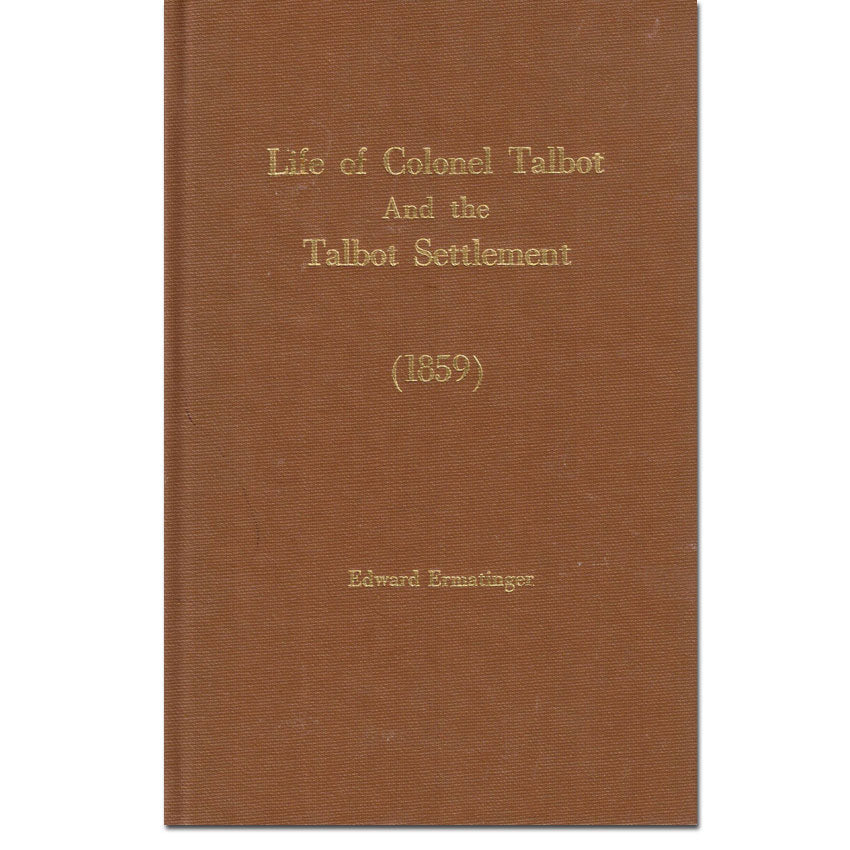Global Heritage Press
Life of Colonel Talbot and the Talbot Settlement
Life of Colonel Talbot and the Talbot Settlement
Couldn't load pickup availability
By Edward Ermatinger (1859)
This is the story of Colonel Talbot and his pioneer settlement scheme in western Upper Canada (Ontario) as told by Edward Ermatinger in 1859.
Ermatinger expressed his opinions and recollections of Talbot very clearly. Many of his contemporaries, and historians since, claim that he unfairly used the book to diminish the reputations of his adversaries, both living and dead. Others have written that Ermatinger provided an all-too-favorable account of Colonel Talbot. With detractors from both camps it is likely that Ermatinger hit somewhere in middle ground.
Contents include:
- Introduction
- Preface
- Contents
- Colonel Talbot's early life and education-Enters the army-Aide-de-camp with Arthur Wellesly in Ireland-Comes to Canada 1790-Becomes Secretary to General Simcoe 1791-Returns to England, 1794, to join his regiment-Rapid Promotion
- Colonel Talbot's return to Canada-Fleming's account of his first visit to the Talbot Settlement with General Simcoe-Settles at Port Talbot 1803-Port Talbot-Colonel Talbot's disgust with the state of Society in England
- Plan of Settlement-Terms of grants of land, from the British Government-Early Settlers-Anecdotes
- Progress of the Settlement-Colonel Burwell-Hardships-Extent of the Talbot Settlement-John Rolph-Captain Matthews
- American War, 1812, and War Stories-Punctuality-Banking and J. K. Woodward
- The Scotch Settlers in Aldboro'-The Audience Window-Jeffery Hunter-Extent of Land placed at the Colonel's disposal
- Letter to Earl Bathurst-Remuneration for services-Jealousy of Officials at Little York
Yarmouth-Hickory Quakers-Dr. Dunlop - Talbot Anniversary-St. Thomas-County of Elgin-London District Officials-The Harris Family
- The Buildings and Domestic Economy of Port Talbot-How the wine dried out in Summer-Visitors-Ex-Sheriff Parkins-The Colonel's Pest-The Pedant
- Colonel Talbot at a Political Meeting in St. Thomas-George Lawton
- The Colonel's Religious Profession-Reasons for not subscribing for a Meeting House-George Elliot's Itinerants
- Hon. Z. Burnham-A Wolf in Sheep's clothing-The Indignant Pretender-A knowing shot Colonel Talbot's reasons for not marrying-Matrimony-A Loving Couple
- Sir A. N. McNab-Militia Training-Colonel Bostwick and the Volunteers-Trip to Oakland-The Queen's Birth Day-D. Rappleje-Bela Shaw
- Sir J. B. Robinson-John Wilson, and the Lawyers of the Settlement
- Bishop Strachan and Bishop Cronyn-the two first Bishops of Upper Canada
- The Mullman-The Colonel's attention to his sick man-Long Sermons-Westover's Morality-Emigration and Old Countrymen
- Original Documents relating to the Talbot Anniversary-Colonel Talbot's principles and Habits-Temperance-The Colonel's declining years
- Colonel Airey-Colonel Talbot goes to England-Differences between the Colonel and Colonel Airey
- Final settlement with Colonel Airey-George McBeth
- Death of Colonel Talbot-Reflections-Funeral
- Conclusion
- Index
Background:
Between 1791 and 1794, Irish born Colonel Thomas Talbot explored the thick, mixed deciduous forest wilderness on the shores of Lake Erie with the Lieutenant-Governor of Upper Canada, John Graves Simcoe. Talbot, unable to forget the wilds of Canada, sold his commission and emigrated to Upper Canada (Ontario) in 1803. He was initially granted 5000 acres of land for his military service.
With the help of Simcoe, Talbot arranged a cozy deal with the crown:
"that 200 acres shall be allotted to him for every family he shall establish thereon, -50 acres thereof to be granted to each family in perpetuity, and the remaining 150 acres of each lot to become his [Talbot's] property, for the expense and trouble of collecting and locating them [the settlers].'
This land was kept in a reserve for Talbot along the shores of Lake Erie. By the time the colonial government forced him to wrap up his operations, his settlers had populated a swath of Ontario land running from east of London clear to Windsor.
Violently contemptuous of government red tape, he was a continual headache to land officials, yet he managed to settle 27 townships with thousands of settlers who cleared more than ½ million acres over very few years.
Living the life of a hermit in a log house on a cliff above Lake Erie, Colonel Thomas Talbot had a steady stream of immigrants visit him to strike a bargain for land. The settler would go to a special window that was much like a wicket in a post office. He would state his business, and if the Colonel had no reason to object to him, out came the Colonel's maps of the area and the settlers name was inscribed in pencil on a 50 or 100 acre parcel. If the Colonel took exception to someone he would dismiss them immediately. If they resisted, he was not above setting the hounds on the unwanted visitor. The eccentric Colonel was truly one of the great characters of Canadian history having pioneered the most successful non-governmental land settlement program in Canada.
About the Author:
Edward Ermatinger (1797-1876) was a Canadian fur trader, businessman, political figure and author of this account of the Life of Colonel Talbot and the Talbot Settlement. He was born on the island of Elba in February of 1797, and was educated in England. Ermatinger settled in St. Thomas, where he served as postmaster, reeve, owned a general store and was manager for the Bank of Upper Canada, then the Commercial Bank and finally the Bank of Montreal. He was elected to the Legislative Assembly of the Province of Canada for Middlesex in 1844 as a Conservative. He was also editor and owner of the St. Thomas Standard, fortuitous considering his political activities. In 1851, he helped found the Bank of the County of Elgin. Edward Ermatinger died at St. Thomas, Ontario in October of 1876.
Details
249 pages
5.75 X 9"
Index
Originally published by A. McLachlin's Home Journal Office, 1859
This edition published by Global Heritage Press, Milton, 2001, 2006 ISBN: 1-894378-94-6 (2006 hardcover)
Share


